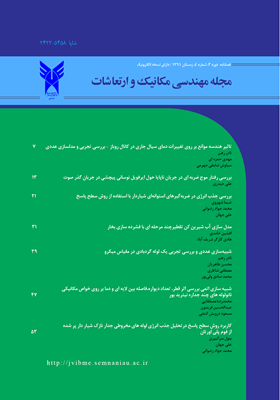کاربرد روش سطح پاسخ درتحلیل جذب انرژی لوله های مخروطی جدار نازک شیار دار پر شده از فوم پلی اورتان
محورهای موضوعی : انتقال ارتعاشاتبتول سرکبیری 1 , علی جهان 2 , محمد جواد رضوانی 3
1 - دانشجو
2 - عضو هیئت علمی
3 - عضو هیئت علمی
کلید واژه: المان محدود, جذب انرژی, روش سطح پاسخ, ضربه پذیری, طراحی آزمایشات,
چکیده مقاله :
چکیده جاذب های انرژی در صنایع مختلف به ویژه در صنایع خودرو سازی به عنوان راه حلی برای کاهش اثر ضربه وارده به سرنشینان و بالا بردن ایمنی خودرو بکار می روند. لولههای جدار نازک به عنوان یکی از کارآمدترین سیستمهای جذب انرژی امروزه کاربرد روزافزونی پیدا کردهاند. دراین تحقیق، جذب انرژی با بررسی تاثیرات متغیر های طراحی مربوط به لوله های جدار نازک مخروط شیار دار با استفاده از آنالیز المان محدود انجام می شود.اما از آنجائیکه که خروجی اینگونه مطالعات بیشتر به نحوه طراحی آزمایشات محاسباتی وابسته است در این مطالعه از تکنیک طراحی آزمایشات همراه با آنالیز المان محدود استفاده شده است. بدین منظور لوله آلومنیومی مخروطی شکل پر شده از فوم پلی اورتان که شیارها در سطوح داخل و خارج آن و با فواصل مساوی ایجاد شده اند ، تحت بار شبه استاتیک شبیه سازی میگردد.هدف طراحی شامل جذب انرژی ویژه و متغیرهای طراحی شامل زاویه مخروط ،فاصله شیارها،چگالی فوم ،عمق شیار و ضخامت لوله است. روش سطح پاسخ نشان می دهد که ضخامت لوله ، چگالی فوم ،عمق شیار و فاصله بین شیارها به ترتیب ذکر شده و بصورت خطی با میزان جذب انرژی ارتباط دارند. این نتایج میتواند در طراحی لوله های جدار نازک مخروطی با هندسه متفاوت مفید باشد.
AbstractEnergy absorbers are used in various – especially in the automotive – industries as a solution to reduce the damages stroke on the passengers, and to enhance automobile safety. Nowadays, thin-walled tubes as one of the most efficient energy absorption systems have found increasing applications. In this study, energy absorption parameters is performed to investigate the impacts of designing variables related to thin-walled conical groove tubes using finite element analysis. However, since the output of these studies depends to methods of designing computational experiments, the design of experiments technique (DOE) is used in this study along with the finite element analysis. For this purpose a conical aluminium tube filled with polyurethane foam is simulated that the grooves are designed with a given distance on the inside and outside surfaces under quasi-static load. Objectives of the design include the specific energy absorption e (SEA), and designing variables including conical angle, grooves distance, foam density, groove depth, and tube thickness. response surface methodology (RSM) showed that the tube thickness foam density, groove depth and grooves distance, respectively and linearly relate to the amount of specific energy absorption These results can be helpful in the design of thin-walled tubes with different conical geometries.

